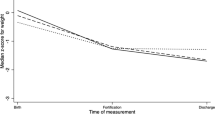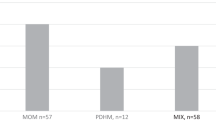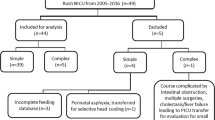Abstract
Objective:
Human milk (donor milk (DM) and/or maternal milk (MM)) feedings protect against late onset sepsis (LOS), necrotizing enterocolitis (NEC) and death. However, DM lacks many anti-infective components of MM. Therefore, we studied exclusive MM feedings to evaluate the full effect of human milk on infectious and other outcomes in premature infants.
Study design:
All infants born before 33 weeks postmenstrual age (PMA) who received exclusive (>95%) MM or exclusive preterm formula (PF) were included in this prospective investigation.
Results:
Sixty-three infants (53%) received MM and 55 infants (47%) received PF. Both groups had similar baseline characteristics. Infants in the MM group achieved full enteral nutrition sooner (14±8 vs 19±15 days, P<0.03) and required a shorter duration of central venous lines (14±10 vs 22±21, P<0.005). Fewer infants in the MM group developed LOS (9 vs 19, P<0.05) and pneumonia (8 vs 16, P<0.05) than PF infants. Only one MM and five PF infants developed NEC (Bell stage ⩾II). Logistic regression analysis using PMA and prolonged rupture of membranes as covariates demonstrated an increased rate of NEC (odds ratio=8.85, CI=1.01 to 25.17, P=0.048) in PF infants. Periventricular leukomalacia (PVL) was more common in PF (4 vs 0, P=0.04) than in MM infants.
Conclusion:
Feedings of MM advanced more rapidly and were associated with fewer infections than PF. A possible protective effect of MM against PVL, not previously described, may be related to its immune and anti-inflammatory components.
This is a preview of subscription content, access via your institution
Access options
Subscribe to this journal
Receive 12 print issues and online access
$259.00 per year
only $21.58 per issue
Buy this article
- Purchase on Springer Link
- Instant access to full article PDF
Prices may be subject to local taxes which are calculated during checkout
Similar content being viewed by others
References
Schanler RJ . Outcomes of human milk-fed premature infants. Semin Perinatol 2011; 35: 29–3.
Castellote C, Casillas R, Ramırez-Santana, Perez-Cano FJ, Castell M, Moretones G et al. Antiinfective properties of human milk. J Nutr 2008; 138: S1801–S1806.
Goldman AS . The immune system in human milk and the developing infant. Breastfeed Med 2007; 2: 195–04.
Lucas A, Cole TJ . Breast milk and neonatal necrotizing enterocolitis. Lancet 1990; 336: 1519–1523.
Schanler RJ, Lau C, Hurst NM, Smith EO . Randomized trial of donor human milk versus preterm formula as substitutes for mothers' own milk in the feeding of extremely premature infants. Pediatrics 2005; 116: 400–406.
Sullivan S, Schanler RJ, Kim JH, Pate AL, Trawoger R, Kiechl-Kohlendorfer U et al. An exclusively human milk-based diet is associated with a lower rate of necrotizing enterocolitis than a diet of human milk and bovine milk-based products. J Pediatr 2010; 156: 562–567.
Meinzen-Derr J, Poindexter B, Wrage L, Morrow AL, Stoll B, Donovan EF et al. Role of human milk in extremely low birth weight infants’ risk of necrotizing enterocolitis or death. J Perinatol 2009; 29: 57–2.
Hylander MA, Strobino DM, Dhanireddy R . Human milk feedings and infection among very low birth weight infants. Pediatrics 1998; 102: e38–e43.
Bell MJ, Ternberg JL, Feigin RD, Keating JP, Marshall R, Barton L et al. Neonatal necrotizing enterocolitis. Therapeutic decisions based upon clinical staging. Ann Surg 1978; 187: 1–7.
Committee for the Classification of Retinopathy of Prematurity. An international classification of retinopathy of prematurity. Arch Ophthalmol 1984; 102: 1130–1134.
Vollset SE, Hirji KF, Affifi AA . Evaluation of exact and asymptotic interval estimators in logistic analysis of matched case-control studies. Biometrics 1991; 47: 1311–1325.
Copyright© 2011 SAS Institute Inc., SAS Campus Drive, Cary, NC 27513, USA.
Kau AL, Ahern PP, Griffin NW, Goodman AL, Gordon JI . Human nutrition, the gut microbiome and the immune system. Nature 2011; 474 (7351): 327–336.
Siggers RH, Siggers J, Thymann T, Boye TM, Sangild PT . Nutritional modulation of the gut microbiota and immune system in preterm neonates susceptible to NEC. JNB 2011; 22: 511–521.
Maayan-Metzger A, Avivi S, Schushan-Eisen I, Kuint J . Human milk versus formula feeding among preterm infants: short-term outcomes. Am J Perinatol 2012; 29: 121–126.
Hogewind-Schoonenboom JE, Rövekamp-Abels LWW, de Wijs-Meijler DPM, Maduro MD, Jansen-van der Weide MC, van Goudoever JB et al. The effect of maternal milk on tolerance and growth in premature infants: a hypothesis-generating study. J Pediatr Gastroenterol Nutr 2017; 64: 971–974.
Hsieh MH, Pai W, Tseng HI, Yang SN, Lu CC, Chen HL . Parenteral nutrition-associated cholestasis in premature babies: risk factors and predictors. Pediatr Neonatol 2009; 50: 202–207.
Campbell LR, Pang Y, Ojeda NB, Zheng B, Rhodes PG, Alexander BT . Intracerebral lipopolysaccharide induces neuroinflammatory change and augmented brain injury in growth-restricted neonatal rats. Pediatr Res 2012; 71: 645–671.
Volpe JJ, Kinney HC, Jensen FE, Rosenberg PA . The developing oligodendrocyte: key cellular target in brain injury in the premature infant. Int J Dev Neurosci 2011; 29: 423–440.
Murase M, Ishida A, Momota T . Early gastrointestinal function and nutritional status in preterm infants with cystic periventricular leukomalacia. Biol Neonate 2002; 82: 78–83.
Sharma R, Tepas JJ 3rd, Hudak ML, Mollitt DL, Wludyka PS, Teng R-J et al. Neonatal gut barrier and multiple organ failure: role of endotoxin and proinflammatory cytokines in sepsis and necrotizing enterocolitis. J Pediatr Surg 2007; 42: 454–461.
Beaino G, Khoshnood B, Kaminski M, Marret S, Pierrat V et alEPIPAGE Study Group. Predictors of the risk of cognitive deficiency in very preterm infants: the EPIPAGE prospective cohort. Acta Paediatr 2011; 100: 370–378.
Lawrence RA . Storage of human milk and the influence of procedures on immunological components of human milk. Acta Paediatr 1999; 88: 14–18.
Evans TJ, Ryley HC, Neale LM, Dodge JA, Lewarne VM . Effect of storage and heat on antimicrobial proteins in human milk. Arch Dis Child 1978; 53: 239–241.
Acknowledgements
This work was supported by NIH Grant RO1 HD059143.
Author information
Authors and Affiliations
Corresponding author
Ethics declarations
Competing interests
The authors declare no conflict of interest.
Rights and permissions
About this article
Cite this article
Cortez, J., Makker, K., Kraemer, D. et al. Maternal milk feedings reduce sepsis, necrotizing enterocolitis and improve outcomes of premature infants. J Perinatol 38, 71–74 (2018). https://doi.org/10.1038/jp.2017.149
Received:
Revised:
Accepted:
Published:
Issue Date:
DOI: https://doi.org/10.1038/jp.2017.149
This article is cited by
-
Pasteurization of human milk affects the miRNA cargo of EVs decreasing its immunomodulatory activity
Scientific Reports (2023)
-
Relationship Between Human Milk Feeding Patterns and Growth in the First Year of Life in Infants with Congenital Heart Defects
Pediatric Cardiology (2023)
-
Health Risk of Infants Exposed to Lead and Mercury Through Breastfeeding
Exposure and Health (2023)
-
A prospective cohort study on lactation status and breastfeeding challenges in mothers giving birth to preterm infants
International Breastfeeding Journal (2022)
-
Breastfeeding and human milk bank in a neonatal intensive care unit: impact of the COVID-19 pandemic in an Italian cohort of very low birth weight infants
International Breastfeeding Journal (2022)



